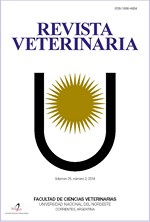Inmunogenicidad de vacunas inactivadas de Salmonella sp de uso en la industria avícola argentina
DOI:
https://doi.org/10.30972/vet.3114636Palabras clave:
Gallinas, Salmonella sp, vacunas inactivadas, inmunogenicidad, control de calidadResumen
La salmonelosis es una de las enfermedades infecciosas más difundidas a nivel mundial, que afecta tanto a seres humanos como a diferentes especies animales, estando históricamente vinculada a la avicultura. Salmonella sp es un microorganismo que puede transmitirse a través de los alimentos y ello implica su impacto en la salud pública, así como también en el comercio internacional de productos y subproductos avícolas. La vacunación es una de las herramientas fundamentales para la contención de estas bacterias y su efectividad requiere de controles de calidad para medir la inmunogenicidad de las mismas. El objetivo de este trabajo fue determinar la inmunogenicidad de tres vacunas comerciales de Salmonella sp aviares de uso en la producción avícola argentina, mediante la inmunización grupal y la determinación de títulos séricos específicos. Grupos de aves fueron vacunadas según un procedimiento estandarizado que incluyó dos vacunaciones. Se observó diversidad de los títulos-aglutinación de Salmonella enteritidis entre las distintas vacunas analizadas, si bien todas ellas generaron seroconversión en las aves. La vacuna 1 presentó los mayores promedios de título, tanto en la primera como en la segunda vacunación, siendo seguida por la vacuna 3 y la vacuna 2. El control de las vacunas tiene como objetivo final estimular la mejoría continua de su calidad para la producción de alimentos más inocuos para la población.
Descargas
Citas
Andres VM, Davies RH. 2015. Biosecurity measures to control Salmonella and other infectious agents in pig farms. Compr Rev Food Sci & Food Saf 14: 317-335.
Barrow P. 1994. Serological diagnosis of Salmonella serotype enteritidis infections in poultry by ELISA and other tests. Int J Food Microbiol 21: 55-68.
Barrow P. 2007. Salmonella infections: immune and nonimmune protection with vaccines. Avian Pathol 36: 1-13.
Barrow P, Lovell M, Berchieri A. 1990. Immunization of laying hens against Salmonella enteritidis with live attenuated vaccines. Vet Rec 126: 241-242.
Caria D. 2017. Salmonelosis en granjas de pollos de engorde en la República Argentina. Tesis de Maestría, Universidad de Buenos Aires, Argentina, p. 16-28.
Desin T, KösterW, Potter A. 2013. Salmonella vaccines in poultry: past, present and future. Expert Rev Vaccines 12: 87-96.
Finn S et al. 2013. Mechanisms of survival, responses, and sources of Salmonella in low-moisture environments. Front Microbiol 4: 331.
Gantois I et al. 2006. Oral immunization of laying hens with the live vaccine strains of TAD Salmonella vac E and TAD Salmonella vac T reduces internal egg contamination with Salmonella enteritidis. Vaccine 24: 6250-6255.
Gast R, Beard C. 1990. Serological detection of experimental Salmonella enteritidis infections in laying hens. Avian Dis 34: 721-728.
Heredia N, García S. 2018. Animals as sources of foodborne pathogens: A review. Anim Nutr 4: 250-255. Hoelzer K et al. 2018. Vaccines as alternatives to antibiotics for food producing animals. Vet Res 49: 64-70.
Humphrey T, Jorgensen, F. 2006. Pathogens on meat and infection in animals. Establishing a relationship using Campylobacter and Salmonella as example. Meat Science 74: 89-97.
Matulova M et al. 2013. SPI-1 defective mutants of Salmonella enterica induce cross-protective immunity in chickens against challenge with serovars Typhimurium and Enteritidis. Vaccine 31: 3156–3162.
Nandre R, Dajeong L. 2015. Cross-protection against Salmonella typhimurium infection conferred by a live attenuated Salmonella enteritidis vaccine. Can J Vet Res 79: 16-21.
Nicholas R, Cullen G. 1991. Development and application of an ELISA for detecting antibodies to Salmonella enteritidis in chicken flocks. Vet Rec 128: 74-76.
OIE. 2018. Salmonelosis. Manual de pruebas de diagnóstico y de vacunas para animales terrestres (versión online), capítulo 2.9.8, pag. 1-18.
Paiva J et al. 2009. Efficacy of several Salmonella vaccination programs against experimental challenge with S.gallinarum in commercial brown layer and broiler breeder hens. Rev Bras Ciência Avíc 11: 65-72.
Pulido LM, Sánchez IR, Guard J, Pinheiro NV. 2013. Assignment of serotype to Salmonella enterica isolates obtained from poultry and their environment in southern Brazil. Lett Appl Microbiol 57: 288-294.
Revolledo L, Ferreira A. 2012. Current perspectives in avian salmonellosis: vaccines and immune mechanisms of protection. J Appl Poult Res 21: 418-431
Rios A et al. 2016. Alternatives to overcoming bacterial resistances: state-of-the-art. Microbiol Res 191: 51-80.
Vandeplas S et al. 2010. Salmonella in chicken: Current and developing strategies to reduce contamination at farm level. J Food Prot 73: 774-785.
Vossrech D et al. 2015. A temporal study of Salmonella enterica serotypes from broiler farms in Brazil. Poult Sci 94: 433-441.
Yang Y et al. 2017. Evaluation of recombinant Salmonella vaccines to provide cross-serovar and cross-serogroup protection. Poult Sci 96: 4352-4360.
Descargas
Publicado
Cómo citar
Número
Sección
Licencia
Derechos de autor 2020 P. Chacana, C. Leiva, P. Joaquim, M. Bombicino, M. V. Terrera

Esta obra está bajo una licencia internacional Creative Commons Atribución-NoComercial 4.0.
Política de acceso abierto
Esta revista proporciona un acceso abierto inmediato a su contenido, basado en el principio de que ofrecer al público un acceso libre a las investigaciones ayuda a un mayor intercambio global de conocimiento. La publicación por parte de terceros será autorizada por Revista Veterinaria toda vez que se la reconozca debidamente y en forma explícita como lugar de publicación del original.
Esta obra está bajo una licencia de Creative Commons Reconocimiento-NoComercial 4.0 Internacional (CC BY-NC 4.0)










.jpg)
.jpg)



